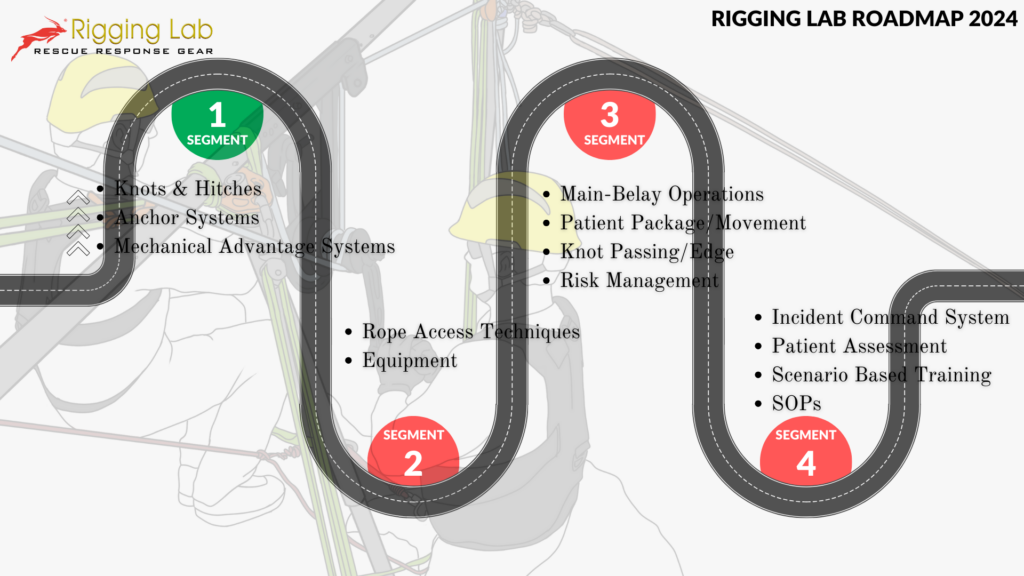Navigating the complexities of rope rescue, emergency responders face a myriad of challenges across both densely populated urban landscapes and the unforgiving terrains of the natural world. This guide juxtaposes the rope rescue techniques honed by fire services—whose jurisdictions span the urban to rural spectrum—with the specialized approaches developed by high-angle search and rescue (SAR) teams, adept in surmounting the natural world’s most daunting obstacles. Through an exploration of the distinct methods, operational strategies, and skill sets each discipline employs, our aim is to illuminate the essential aspects of rope rescue operations. Such an understanding is crucial for emergency responders, empowering them with the knowledge and agility needed to conduct effective rescues under the most dire circumstances, safeguarding both their lives and those of the individuals they endeavor to save.
Rope Rescue in the Fire Service
Jurisdiction and Environment:
- Fire departments are tasked with a wide jurisdiction that includes urban, suburban, and rural areas. Their rope rescue operations must be versatile enough to address scenarios ranging from high-rise buildings in cities to cliffs and canyons in rural areas.
- This versatility requires a broad set of rope rescue techniques and strategies to effectively respond to emergencies in any setting, whether it involves rescuing a person trapped in a confined space, over a steep embankment, or within a collapsed structure.
Method and Operations:
- The methods and operations in fire service rope rescue are diverse, reflecting the varied environments and situations encountered. These can range from straightforward rappels and lowerings in urban settings to more complex high-angle rescues in natural environments.
- Firefighters are trained to rapidly assess situations and deploy rope rescue techniques that can be adapted to the specific challenges of the incident, emphasizing efficiency and safety.
Skills:
- Versatile Rope Skills: Firefighters are trained in a wide range of rope rescue skills, from basic to advanced, to ensure they can adapt to any situation. This includes knot tying, anchor system creation, and the use of mechanical advantage systems.
- Adaptation to Multiple Environments: Firefighters must be adept at performing rope rescues in a variety of settings, requiring skills in environmental assessment, hazard recognition, and the application of different rescue techniques based on the scenario.
- Integrated Rescue Techniques: In addition to rope skills, firefighters integrate medical response, extrication techniques, and water rescue skills into their rope rescue operations, reflecting the multifaceted nature of emergencies they face.
Perception and Perspective:
- Within the fire service, rope rescue is viewed as an integral part of their overall emergency response capability. The perspective is holistic, focusing on versatility, rapid response, and the ability to manage complex rescues in any environment.
- The emphasis is on a pragmatic approach to rescue, with a strong foundation in rope rescue skills complemented by the ability to integrate other emergency response techniques as needed.
High-Angle SAR Rope Rescue
Jurisdiction and Environment:
- High-angle SAR teams specialize in challenging terrains such as mountains, cliffs, and other remote areas. Their operations are often focused on natural environments, though they can also be called upon for urban high-angle scenarios.
- The emphasis is on navigating and operating in difficult-to-access locations, where traditional rescue methods may not be feasible.
Method and Operations:
- SAR operations are characterized by complex rigging and technical rope systems designed for stability, safety, and the ability to negotiate difficult terrains.
- These operations require careful planning and execution, with a focus on minimizing risk in environments where external factors such as weather and terrain can significantly impact rescue efforts.
Skills:
- Technical Expertise: High-angle SAR personnel possess advanced technical skills in rope rescue, including the use of specialized equipment and techniques suited to natural and challenging terrains.
- Environmental Mastery: They have a deep understanding of the environments in which they operate, enabling them to make informed decisions about the safest and most effective rescue methods.
Perception and Perspective:
- High-angle SAR views rope rescue as a specialized field requiring extensive technical knowledge and skill. The perspective is analytical, with an emphasis on precision, planning, and adaptation to the natural environment.
Comparative Overview
The fire service’s approach to rope rescue encompasses a broad spectrum of scenarios, reflecting their wide-ranging responsibilities across urban, suburban, and rural environments. Their operations prioritize versatility, rapid deployment, and the integration of rope rescue with other emergency response skills. In contrast, high-angle SAR operations are specialized, focusing on technical proficiency and environmental adaptation in challenging terrains.
Both disciplines require a high level of skill and training, but their methods, operations, and perspectives are tailored to the specific environments and situations they are most likely to encounter. Understanding these distinctions is crucial for developing effective training programs and operational protocols that meet the unique needs of each group, ensuring that responders are prepared to execute rope rescues safely and efficiently, regardless of the scenario.










